Amy
Forum Replies Created
-
AmyParticipant
 I started this course in fall 2019. I kept meaning to get back to it after the holidays, but then, well, life got interesting for all of us. Finally I finished the second picture! I was able to be more detailed and more adventurous the second time around, and more accurate with the colors. I used a glaze for the background and established a palette, with notes, that I was able to recreate over two years later. I still had trouble with smudging the eye! I am also working on getting the right amount of pigment and water on the brush, and steady brushstrokes. I’m a much more confident artist now when I actually paint! in reply to: See How Far You’ve Come #863054
I started this course in fall 2019. I kept meaning to get back to it after the holidays, but then, well, life got interesting for all of us. Finally I finished the second picture! I was able to be more detailed and more adventurous the second time around, and more accurate with the colors. I used a glaze for the background and established a palette, with notes, that I was able to recreate over two years later. I still had trouble with smudging the eye! I am also working on getting the right amount of pigment and water on the brush, and steady brushstrokes. I’m a much more confident artist now when I actually paint! in reply to: See How Far You’ve Come #863054 -
AmyParticipant
 First watercolor sketch in the field. I highly recommend a thermos of tea for chilly days! I wish I’d remembered to bring a paper towel or rag, but otherwise I was happy with my kit.
I enjoyed the process immensely. Working in color, I see things I wouldn’t notice if I were just drawing or writing, like how much moss was on the gnarled oak that is the focal point. And it’s fun mixing colors, though I quickly ran out of palette space. If I had it to do over again, I think I would use dry-on-dry for a lot of that tree, different layers of different colors.
I have a lot to learn before I can get sketches out of the ugly duckling stage in less than an hour, but looking at it now I realize how much the sketch brings back: not just the tree but the feeling of sitting right next to the creek in the damp air and hearing all the birds around me. This little creek is a tiny ribbon of woodland in ag fields and the birds, well, flock to it. in reply to: Filling Your Sketches with Color #654089
First watercolor sketch in the field. I highly recommend a thermos of tea for chilly days! I wish I’d remembered to bring a paper towel or rag, but otherwise I was happy with my kit.
I enjoyed the process immensely. Working in color, I see things I wouldn’t notice if I were just drawing or writing, like how much moss was on the gnarled oak that is the focal point. And it’s fun mixing colors, though I quickly ran out of palette space. If I had it to do over again, I think I would use dry-on-dry for a lot of that tree, different layers of different colors.
I have a lot to learn before I can get sketches out of the ugly duckling stage in less than an hour, but looking at it now I realize how much the sketch brings back: not just the tree but the feeling of sitting right next to the creek in the damp air and hearing all the birds around me. This little creek is a tiny ribbon of woodland in ag fields and the birds, well, flock to it. in reply to: Filling Your Sketches with Color #654089 -
AmyParticipantWhen I was younger I was taught wet-on-wet but not the others. It was frustrating. This time I enjoyed it because I was curious what the paint would do. I like paintings that explore color, and wet on wet is a fun way to do it. I grew up in a watery area, and wet-on-wet is perfect for the play of light and color on water, or in the sky, or for fuzzy things in the distance. Wet on dry comes easiest. I like the possibility of detail. I’m still working on getting the right balance of pigment to water so I’m not getting that splodge at the end of the stroke. I had to really work at it to get the brush dry enough for dry on dry, but I like it for rough textures or stuttered white. It would be interesting to put a dry color over a lighter color so the light one shows through. I was thinking of sharing a wet on wet landscape sketch, but picked up the paper before it was dry and smudged it. Learn from my my mistake, y’all.in reply to: Getting Comfortable with Watercolor #652662
-
AmyParticipant

 Here are the fruits of my labors. I enjoyed trying different combinations of complimentary colors. They turned out really differently depending on how much of each color I used.
I did a little with watercolors as a youngster, but I didn’t know much about color mixing. And handling the brush and getting the right amount of water is challenging. But the color mixing is getting easier as I get to know the colors. The Rosy-Finch was especially interesting because I used a lot of the same base colors, just in different combinations and quantities. I’m looking forward to trying this with actual objects. in reply to: Capturing Nature’s Color Palettes #652361
Here are the fruits of my labors. I enjoyed trying different combinations of complimentary colors. They turned out really differently depending on how much of each color I used.
I did a little with watercolors as a youngster, but I didn’t know much about color mixing. And handling the brush and getting the right amount of water is challenging. But the color mixing is getting easier as I get to know the colors. The Rosy-Finch was especially interesting because I used a lot of the same base colors, just in different combinations and quantities. I’m looking forward to trying this with actual objects. in reply to: Capturing Nature’s Color Palettes #652361 -
AmyParticipantThe opposite of gesture drawing! This took me three sittings, a bit at a time, and really broke in my eraser. Eventually I was able to surrender to the process, and I’m happy with how it came out. I remember the upside-down drawing exercise from Drawing on the Right Side of the Brain—that’s what took me from stick figures to thinking, Oh, that’s how you draw! This was a lot more exacting, much more of an exercise in patience. Worth it, too.
 in reply to: Drawing What You See – Upside Down Drawing #649560
in reply to: Drawing What You See – Upside Down Drawing #649560 -
AmyParticipant
 I think this class is working! I looked at this eggplant and thought how pretty it is, but expected the drawing to be mush. The actual eggplant is prettier and the shadows need something, but I was pleased with how it came out.
It turns out that my middle-aged eyes can see either the pencil point or the distant object but not both, so I’ll need to experiment with checking proportions. Negative space helped for getting the leaf shapes right. Gesture drawing frequently also helps: it makes me decide what’s essential. in reply to: Getting the Proportions Right #649423
I think this class is working! I looked at this eggplant and thought how pretty it is, but expected the drawing to be mush. The actual eggplant is prettier and the shadows need something, but I was pleased with how it came out.
It turns out that my middle-aged eyes can see either the pencil point or the distant object but not both, so I’ll need to experiment with checking proportions. Negative space helped for getting the leaf shapes right. Gesture drawing frequently also helps: it makes me decide what’s essential. in reply to: Getting the Proportions Right #649423 -
AmyParticipantNice! Welcome to CA! The frame helps me too with negative space.in reply to: Getting the Proportions Right #649422
-
AmyParticipantVerbena?in reply to: Getting the Proportions Right #649203
-
AmyParticipantI got a kick out of my jumping fox drawing because it has so much energy. The pic of birds on a wire I’m posting not because it’s a great drawing but because I’ve always thought birds on a wire were all the same and in 2 minutes I produced proof that they aren’t. They move around, they face different ways, they have different postures. I’ve been doing a lot of bird sketches and every time I see something new.

 in reply to: Capturing Behavior – Gesture Drawing #649155
in reply to: Capturing Behavior – Gesture Drawing #649155 -
AmyParticipantI really enjoyed doing this from a photo. I liked starting with the curvy newt. That gave me a sense of rhythm. Doing a contour drawing from an object with foreshortening and a lot of light and shadow was harder, but it’s such a great warmup to really see the shapes.
 in reply to: Focusing on Your Subject – Blind Contour Drawing #648912
in reply to: Focusing on Your Subject – Blind Contour Drawing #648912 -
AmyParticipantKudos for posting this! It’s kind of like the top was at the beginning of the jump and the bottom was at the peak.in reply to: Focusing on Your Subject – Blind Contour Drawing #648910
-
AmyParticipantThere’s so much information I want to get in that it’s hard to get it on the page, and between my lack of drawing practice and a certain rush to do the work, the art is literally sketchy. Even working as quickly as I could, this took me about an hour and a half. But I really enjoy the chance to observe. I spend a lot of time grubbing up Bermuda grass and crab grass, so this was a “know thy enemy” exercise. By the time I was done I at least appreciated the structure of both grasses and understood a bit better how they spread. And I’d never noticed the pretty purple on some of the Bermuda grass stems before. Now I’m curious why some are purple and some aren’t.
 in reply to: The Power of Comparison #648877
in reply to: The Power of Comparison #648877 -
AmyParticipantI have been fascinated by the nuthatches (at least two) that have been visiting my sunflowers. I have so many questions! 1. They’re here, in the suburbs, separated from forest by miles of orchards and tomato fields. What are they doing in my back yard? Possible explanations:
- they’re young and lost and exploiting any food source they can.
- They normally live in fir forest and there’s a fir nearby. Maybe that attracted them.
- I’ve just read that they will travel if their habitat is damaged. Last year there were massive fires throughout the state, including the nearest fir forest. Maybe they are climate refugees.
- Maybe they also eat seeds.
- Maybe they’re caching seeds in hopes of generating bugs.
- Maybe they eat and cache seeds.
- Clearly they can exploit food the finches can’t.
- One theory is that they can find insects hiding in bark better from that angle.
- Do they also eat fir seeds? Is there something about, say, perching on top of a fir cone and working downward that would make it easy to get the seeds out?
in reply to: Noticing Themes in Nature #648677 -
AmyParticipant
 I’ve kept a written journal for decades, and clearly that comes more naturally to me than drawing. Also, the birds were the most striking things for me, and they were not hanging around for sketches! I was also very interested in the sounds of the birds. Usually I’m more of a plant person, but the back yard is mostly weeds I’m trying to get rid of, senescent veggie garden—and the sunflower stalks that bring in the birds, piquing my curiosity about them. in reply to: Opening Your Senses #648675
I’ve kept a written journal for decades, and clearly that comes more naturally to me than drawing. Also, the birds were the most striking things for me, and they were not hanging around for sketches! I was also very interested in the sounds of the birds. Usually I’m more of a plant person, but the back yard is mostly weeds I’m trying to get rid of, senescent veggie garden—and the sunflower stalks that bring in the birds, piquing my curiosity about them. in reply to: Opening Your Senses #648675 -
AmyParticipantGlad you made it through, Gayle. Several people in my life were affected by the fire, fortunately all safe and sound.in reply to: Opening Your Senses #648673
-
AmyParticipant
 I got very involved with the light and shadow on the leaves of the persimmon and struggled with, say, the shadows being similar values to the persimmon next to them. Same with the pepper, as though a similar amount of light was being reflected from the pepper and from the paper but in different ways. Also, I realized I had 3 nearby windows and so 3 light sources!
Well, I’m always up for a challenge. One thing I learned from this was to think in terms of shapes of light and dark as well as values. And I think I’m seeing much, much more already. in reply to: Illustrating the 3D World #648184
I got very involved with the light and shadow on the leaves of the persimmon and struggled with, say, the shadows being similar values to the persimmon next to them. Same with the pepper, as though a similar amount of light was being reflected from the pepper and from the paper but in different ways. Also, I realized I had 3 nearby windows and so 3 light sources!
Well, I’m always up for a challenge. One thing I learned from this was to think in terms of shapes of light and dark as well as values. And I think I’m seeing much, much more already. in reply to: Illustrating the 3D World #648184 -
AmyParticipant
@Tania Me too!
in reply to: Jump Right in! #646253 -
AmyParticipantI laughed at “wait until the paint is dry...” I had the same lesson.in reply to: Jump Right in! #646250
-
AmyParticipantI haven’t used watercolors since I was a kid, so I was pretty intimidated at first. But I had more fun than I expected. I thought mixing colors would be hard, and I definitely have a lot to learn, but it was magical how I could get to a first approximation fairly quickly. I was using a set of cheap brushes and decent ones are on my shopping list. Brush control was a bear and my tools weren’t helping me out. I wouldn’t have noticed color variation nearly as much if I’d just been looking at a photo, nor the way the ends of the primaries pile up toward the tail. The black and yellow striped effect makes me wonder what the wings look like in flight.
 in reply to: Jump Right in! #646245
in reply to: Jump Right in! #646245 -
AmyParticipantYes, Obi's work is beautiful!in reply to: Style Your Journal Your Way #645568
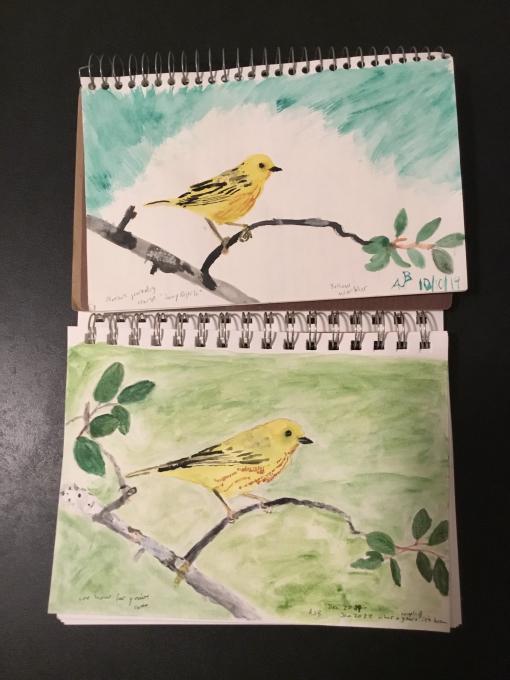 I started this course in fall 2019. I kept meaning to get back to it after the holidays, but then, well, life got interesting for all of us. Finally I finished the second picture! I was able to be more detailed and more adventurous the second time around, and more accurate with the colors. I used a glaze for the background and established a palette, with notes, that I was able to recreate over two years later. I still had trouble with smudging the eye! I am also working on getting the right amount of pigment and water on the brush, and steady brushstrokes. I’m a much more confident artist now when I actually paint!
I started this course in fall 2019. I kept meaning to get back to it after the holidays, but then, well, life got interesting for all of us. Finally I finished the second picture! I was able to be more detailed and more adventurous the second time around, and more accurate with the colors. I used a glaze for the background and established a palette, with notes, that I was able to recreate over two years later. I still had trouble with smudging the eye! I am also working on getting the right amount of pigment and water on the brush, and steady brushstrokes. I’m a much more confident artist now when I actually paint!  First watercolor sketch in the field. I highly recommend a thermos of tea for chilly days! I wish I’d remembered to bring a paper towel or rag, but otherwise I was happy with my kit.
I enjoyed the process immensely. Working in color, I see things I wouldn’t notice if I were just drawing or writing, like how much moss was on the gnarled oak that is the focal point. And it’s fun mixing colors, though I quickly ran out of palette space. If I had it to do over again, I think I would use dry-on-dry for a lot of that tree, different layers of different colors.
I have a lot to learn before I can get sketches out of the ugly duckling stage in less than an hour, but looking at it now I realize how much the sketch brings back: not just the tree but the feeling of sitting right next to the creek in the damp air and hearing all the birds around me. This little creek is a tiny ribbon of woodland in ag fields and the birds, well, flock to it.
First watercolor sketch in the field. I highly recommend a thermos of tea for chilly days! I wish I’d remembered to bring a paper towel or rag, but otherwise I was happy with my kit.
I enjoyed the process immensely. Working in color, I see things I wouldn’t notice if I were just drawing or writing, like how much moss was on the gnarled oak that is the focal point. And it’s fun mixing colors, though I quickly ran out of palette space. If I had it to do over again, I think I would use dry-on-dry for a lot of that tree, different layers of different colors.
I have a lot to learn before I can get sketches out of the ugly duckling stage in less than an hour, but looking at it now I realize how much the sketch brings back: not just the tree but the feeling of sitting right next to the creek in the damp air and hearing all the birds around me. This little creek is a tiny ribbon of woodland in ag fields and the birds, well, flock to it. 
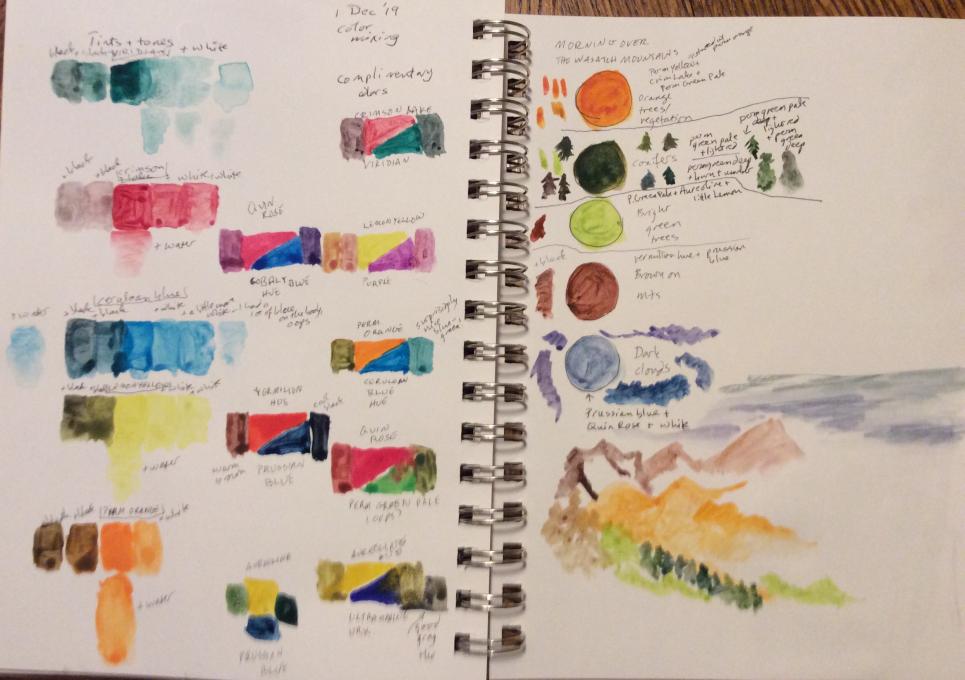 Here are the fruits of my labors. I enjoyed trying different combinations of complimentary colors. They turned out really differently depending on how much of each color I used.
I did a little with watercolors as a youngster, but I didn’t know much about color mixing. And handling the brush and getting the right amount of water is challenging. But the color mixing is getting easier as I get to know the colors. The Rosy-Finch was especially interesting because I used a lot of the same base colors, just in different combinations and quantities. I’m looking forward to trying this with actual objects.
Here are the fruits of my labors. I enjoyed trying different combinations of complimentary colors. They turned out really differently depending on how much of each color I used.
I did a little with watercolors as a youngster, but I didn’t know much about color mixing. And handling the brush and getting the right amount of water is challenging. But the color mixing is getting easier as I get to know the colors. The Rosy-Finch was especially interesting because I used a lot of the same base colors, just in different combinations and quantities. I’m looking forward to trying this with actual objects. 
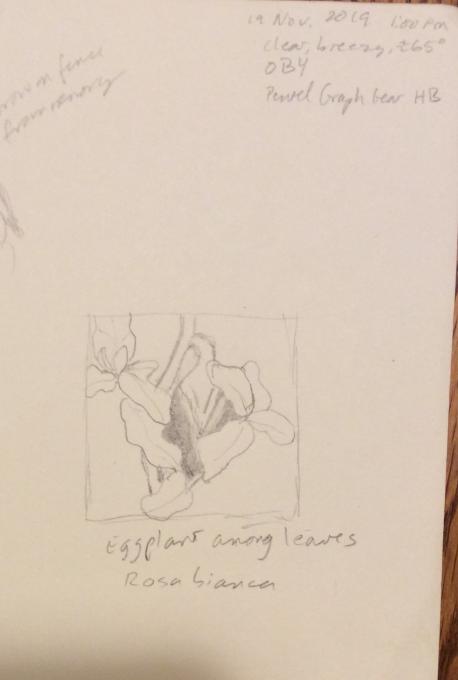 I think this class is working! I looked at this eggplant and thought how pretty it is, but expected the drawing to be mush. The actual eggplant is prettier and the shadows need something, but I was pleased with how it came out.
It turns out that my middle-aged eyes can see either the pencil point or the distant object but not both, so I’ll need to experiment with checking proportions. Negative space helped for getting the leaf shapes right. Gesture drawing frequently also helps: it makes me decide what’s essential.
I think this class is working! I looked at this eggplant and thought how pretty it is, but expected the drawing to be mush. The actual eggplant is prettier and the shadows need something, but I was pleased with how it came out.
It turns out that my middle-aged eyes can see either the pencil point or the distant object but not both, so I’ll need to experiment with checking proportions. Negative space helped for getting the leaf shapes right. Gesture drawing frequently also helps: it makes me decide what’s essential. 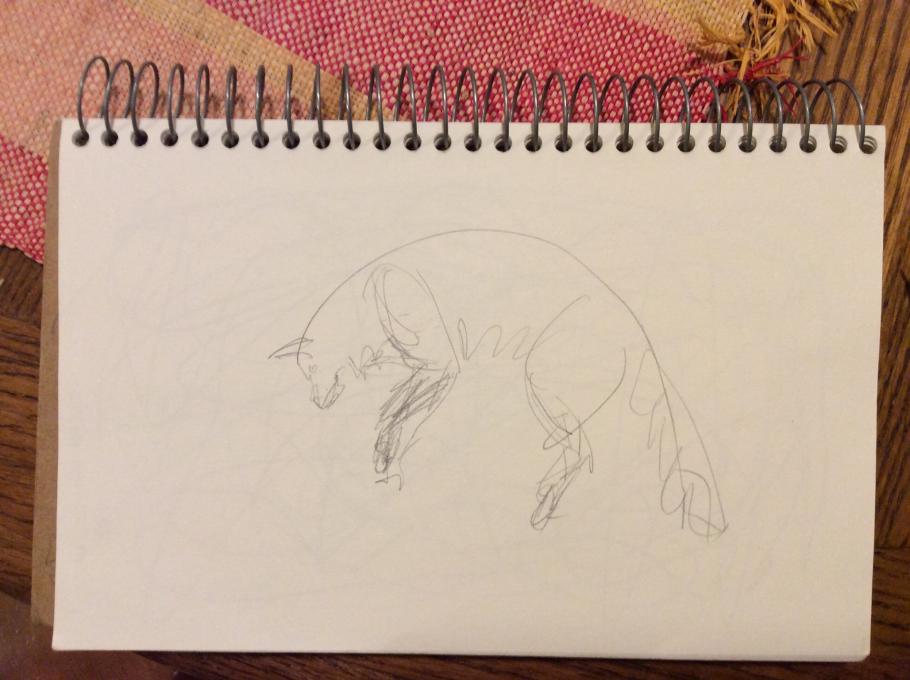
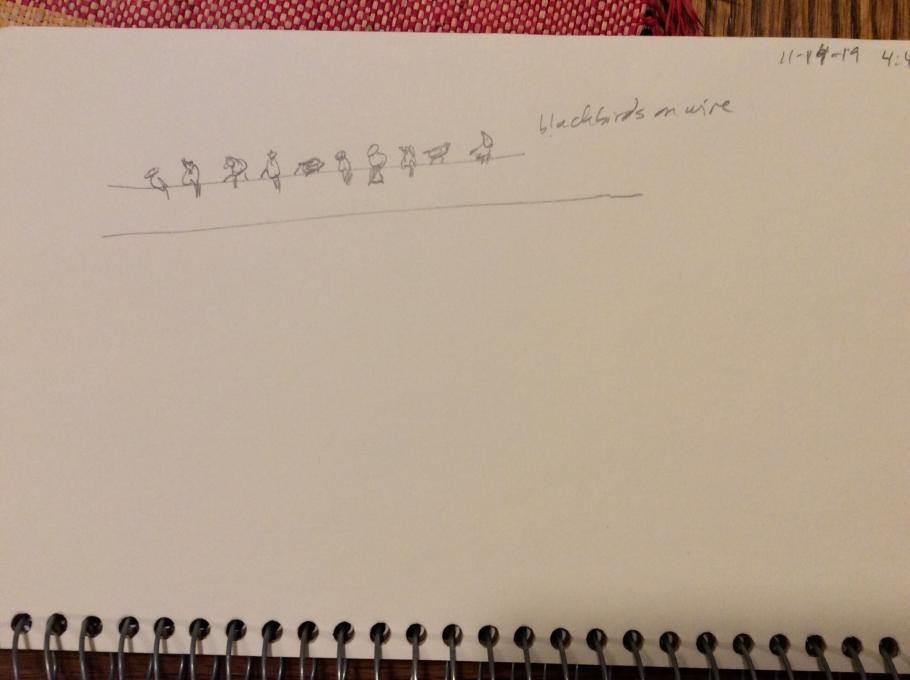
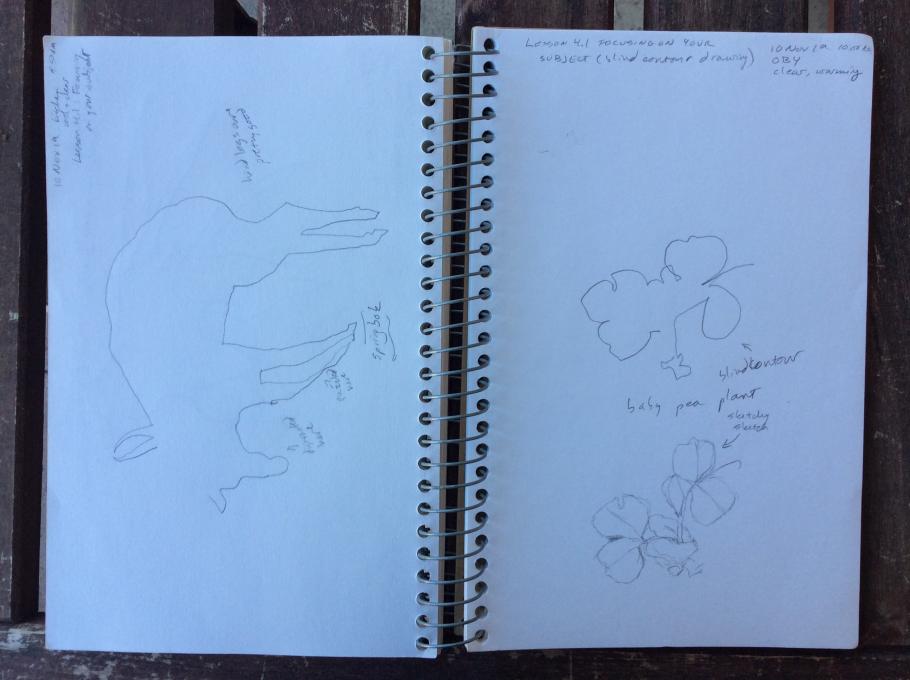
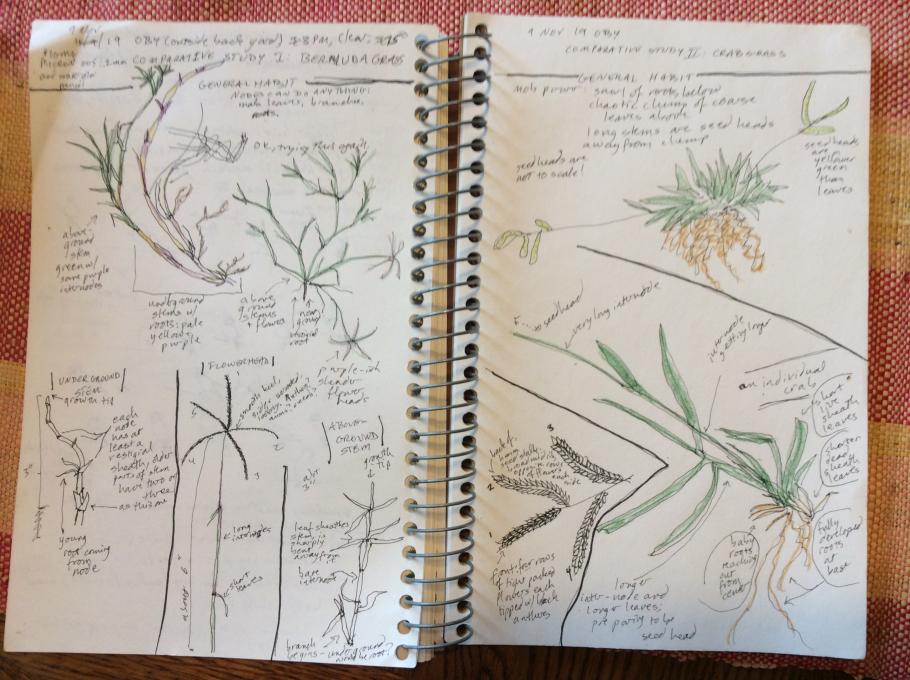
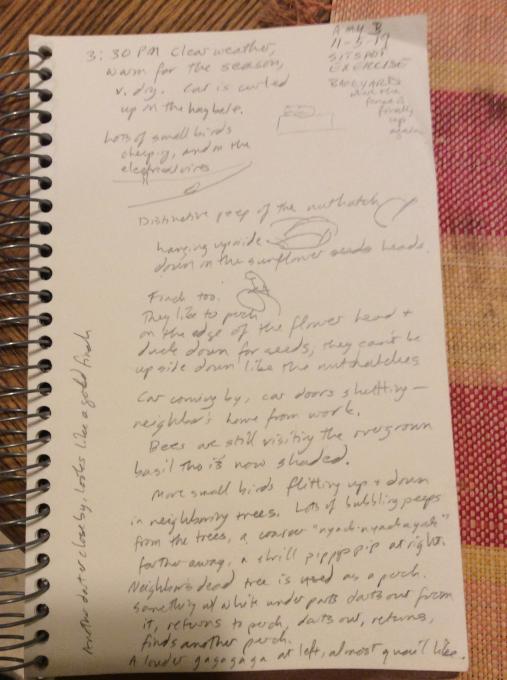 I’ve kept a written journal for decades, and clearly that comes more naturally to me than drawing. Also, the birds were the most striking things for me, and they were not hanging around for sketches! I was also very interested in the sounds of the birds. Usually I’m more of a plant person, but the back yard is mostly weeds I’m trying to get rid of, senescent veggie garden—and the sunflower stalks that bring in the birds, piquing my curiosity about them.
I’ve kept a written journal for decades, and clearly that comes more naturally to me than drawing. Also, the birds were the most striking things for me, and they were not hanging around for sketches! I was also very interested in the sounds of the birds. Usually I’m more of a plant person, but the back yard is mostly weeds I’m trying to get rid of, senescent veggie garden—and the sunflower stalks that bring in the birds, piquing my curiosity about them.  I got very involved with the light and shadow on the leaves of the persimmon and struggled with, say, the shadows being similar values to the persimmon next to them. Same with the pepper, as though a similar amount of light was being reflected from the pepper and from the paper but in different ways. Also, I realized I had 3 nearby windows and so 3 light sources!
Well, I’m always up for a challenge. One thing I learned from this was to think in terms of shapes of light and dark as well as values. And I think I’m seeing much, much more already.
I got very involved with the light and shadow on the leaves of the persimmon and struggled with, say, the shadows being similar values to the persimmon next to them. Same with the pepper, as though a similar amount of light was being reflected from the pepper and from the paper but in different ways. Also, I realized I had 3 nearby windows and so 3 light sources!
Well, I’m always up for a challenge. One thing I learned from this was to think in terms of shapes of light and dark as well as values. And I think I’m seeing much, much more already. 